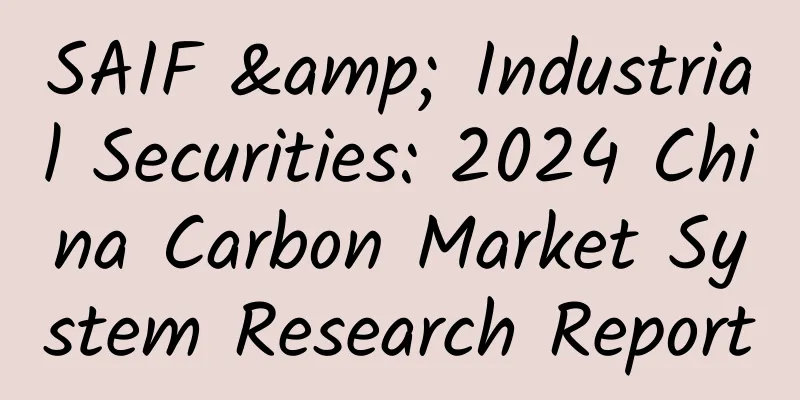SAIF & Industrial Securities: 2024 China Carbon Market System Research Report

|
Carbon emission quotas are one of the basic trading products of the carbon emission trading system. In 2011, the National Development and Reform Commission issued the "Notice on the Pilot Work of Carbon Emission Trading", selecting seven provinces and cities, including Beijing, Tianjin, Shanghai, Chongqing, Hubei, Guangdong and Shenzhen, to carry out the pilot construction of regional carbon emission trading markets. In 2013, the Shenzhen carbon emission trading market was officially launched, becoming the first pilot carbon market in China, and other pilot markets were subsequently launched. At the end of 2016, the Fujian carbon emission trading market was launched. The regional pilot has made innovative attempts in the coverage of the carbon market, the quota allocation method, the compliance and use of offset quotas and other rules, providing valuable experience for further improving the carbon trading mechanism. At the beginning of operation, each pilot market issued corresponding carbon emission trading management measures in the form of local people's congress regulations or local government orders, which stipulated the total quota and allocation and management, trading, monitoring, reporting and verification, incentive and constraint mechanisms. The establishment of laws and regulations is a prerequisite for the effective operation of the carbon emission trading market. After the national carbon market was launched, some pilot markets revised the original management methods or promulgated new methods in order to further implement the dual carbon goals and clarify the management boundaries and connection mechanisms with the national carbon market. In terms of the types of greenhouse gases covered, in the initial stage of the pilot, only Chongqing covered the six gases regulated by the first commitment period of the Kyoto Protocol, namely carbon dioxide, methane, nitrous oxide, hydrofluorocarbons, perfluorocarbons and sulfur hexafluoride, while other pilot markets only covered carbon dioxide. From the perspective of participation thresholds, each pilot market sets its own threshold based on the coverage industries and according to its own development status, mostly based on the annual carbon dioxide equivalent of greenhouse gas emissions. When determining the coverage industries, each pilot market fully considers its own economic structure. For example, Beijing and Shanghai give priority to the inclusion of the service industry, Shanghai later includes the shipping industry, and Guangdong adds papermaking and civil aviation industries. When setting the threshold, different thresholds are set for industrial enterprises and other enterprises, and Shanghai sets different thresholds for enterprises in different industries. Moreover, in the process of development, each pilot market continues to lower the emission threshold and expand the coverage industries to cover more enterprises. The document link will be shared to 199IT Knowledge Planet. Scan the QR code below to view it! |
<<: If you want to use iPhone 7 in winter, you have to be careful with the Home button
>>: Brighter, wider color gamut: What does it mean that the iPhone 7 screen supports DCI-P3?
Recommend
Toyota invests 19 billion to establish a new company and will let driverless cars drive on the highway in two years
Tesla and Internet companies such as Google are n...
The era is over! Netizens say that Symbian phones can no longer log in to QQ/WeChat
From the arcade N73, to the T9 flagship N95, to t...
Jiangsu 2020 College Entrance Examination Score Line: Jiangsu 2020 College Entrance Examination Admission Score Line Announced
The undergraduate score line that Jiangsu candida...
It only takes 3 steps to reduce the cost of information flow advertising. Which step have you taken?
Dear optimizer friends, have you ever encountered...
0-cost communication strategy: 6 tips to help you create a hit product
When we do growth, we tend to focus on one thing,...
What is left after Haier launched the transparent factory "naked chat"?
According to the news, on August 11, Haier held a...
He is the first Chinese to win the "Nobel Prize for Meteorology" and made a bold statement: "Let foreigners catch up with us"|Time Letter
Nowadays, weather forecast has become a piece of ...
Windows 10 cannot be activated? Try this trick
Microsoft officially launched the Windows 10 Buil...
Tesla officially announced its plan to build a factory in Shanghai
Electric car manufacturer Tesla's plan to bui...
Kobe Bryant endorses Ele.me, and it only takes five steps to pass the level!
These days, Kris Wu is the spokesperson for Honor...
China Association of Automobile Manufacturers: A brief overview of automobile industry production and sales in July 2022
At present, my country's economy is at a crit...
Big news! The birth of a machine-organoid hybrid "biological computer"! It may overcome the bottleneck of AI hardware
The human brain, the "command center" o...
HTC One with WP8 GDR3 system to be unveiled at the end of the year: supports Wi-Fi data recovery and rotating lock screen
[September 9 news] Screenshots of the WP8 version...
How much does it cost to customize the Chengde Paper Products Mini Program? What is the price quote for Chengde Paper Products Mini Program customization?
The main factors affecting the price of mini prog...
Independent mobile game developers earn 80,000 yuan a month: review the detailed process of listing
It is said that mobile games have brought the sta...









